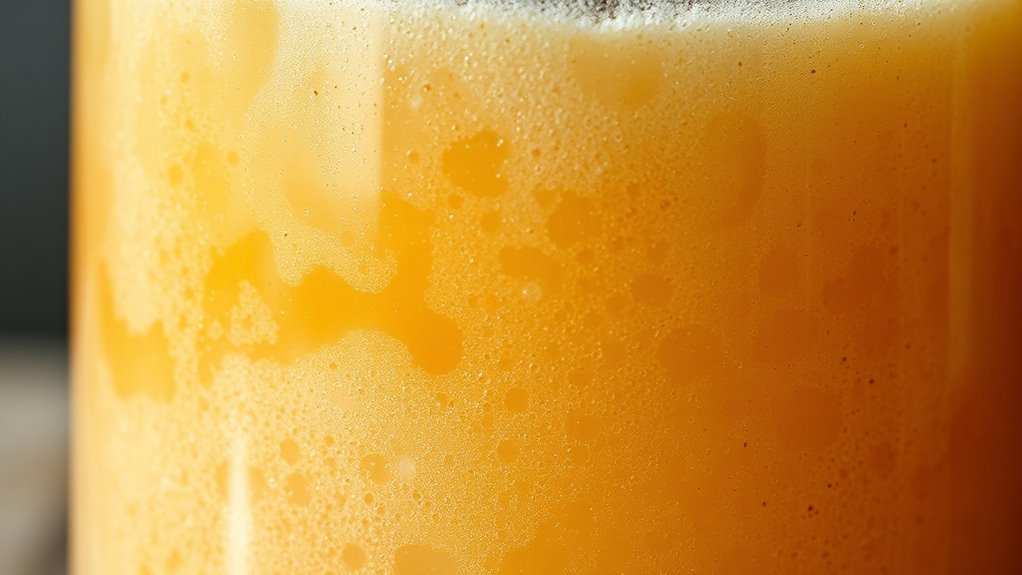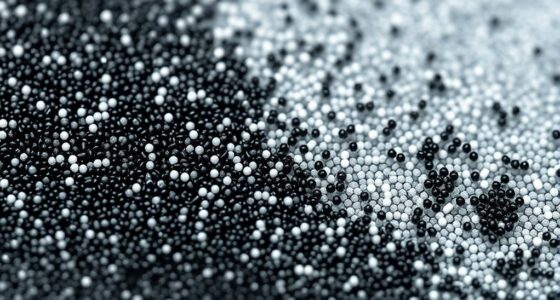Sourdough starter fermentation relies on a community of yeasts and bacteria developing from ingredients, environment, and human contact. Yeasts break down sugars into CO₂ and alcohol to leaven bread, while bacteria produce lactic and acetic acids that add tang and preserve it. Factors like temperature, hydration, and pH influence these microbes’ activity. The byproducts create flavor, aroma, and health benefits, making fermentation a complex, finely balanced process that shapes your sourdough’s unique character. Explore further to uncover more about this fascinating biological transformation.
Key Takeaways
- Microbial communities in sourdough starters originate from flour, environment, and human contact, shaping unique fermentation profiles.
- Yeasts produce CO₂ and ethanol, leavening dough and influencing aroma, while bacteria generate lactic and acetic acids, adding sourness and preserving the bread.
- Organic acids lower pH, inhibit spoilage organisms, and enhance flavor, nutritional bioavailability, and dough elasticity.
- Fermentation conditions like temperature, pH, and hydration levels regulate microbial activity and community composition.
- Microbial interactions through cross-feeding and metabolite production ensure a stable, resilient ecosystem that defines sourdough’s flavor and health benefits.
Microbial Communities in Sourdough Starters
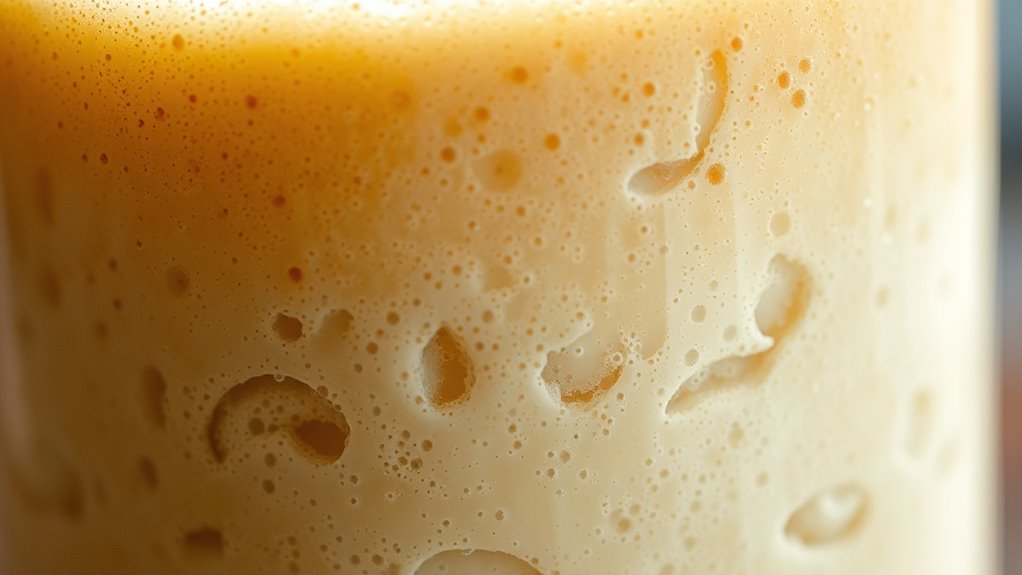
Microbial communities in sourdough starters originate from multiple sources, with flour serving as the primary reservoir of microbes such as wild yeast and bacteria. When you mix flour and water, you introduce a diverse array of microorganisms from the flour itself, along with environmental factors like air, utensils, and your skin.
Microbial communities in sourdough starters mainly come from flour, environment, and human contact.
Over time, these microbes evolve through natural selection, creating unique profiles for each starter. Human contact, especially microbes from your hands, can influence the community’s composition and flavor.
Some starters have been preserved for thousands of years, maintaining distinct microbial communities. This diversity includes lactic acid bacteria and yeasts, which dominate the fermentation process.
Your sourdough’s microbial makeup is shaped by these sources, forming the foundation for its flavor and leavening qualities.
How Yeasts and Bacteria Collaborate
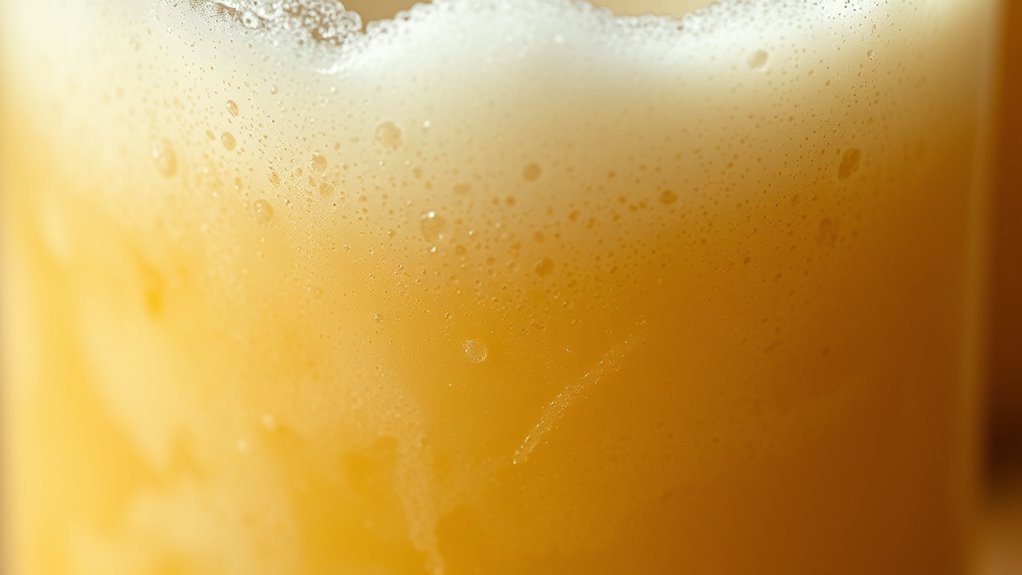
Yeasts and bacteria in sourdough starters work together in a mutually beneficial relationship, sharing nutrients rather than competing for them. Yeasts ferment sugars into carbon dioxide and alcohol, causing the dough to rise and develop texture. A variety of microbial interactions occur within the starter, ensuring a balanced and resilient ecosystem. Simultaneously, bacteria metabolize sugars into lactic and acetic acids, adding sour flavor and helping preserve the starter. They also lower the pH, creating an environment that inhibits spoilage microbes. Yeasts break down complex carbohydrates into simpler sugars that both microbes can use, while bacteria produce acids that influence flavor. Some yeast metabolites, like alcohol, serve as nutrients for bacteria, fostering cross-feeding. This collaboration speeds up fermentation, enhances aroma, and stabilizes the microbial community, ensuring sustained activity and consistent bread quality.
Fermentation Byproducts and Their Functions

During fermentation, various byproducts are produced that play essential roles in shaping the characteristics of sourdough bread. Ethanol, generated by yeast, influences aroma complexity and can inhibit spoilage organisms, helping keep your starter stable. Although mostly volatilized during baking, ethanol contributes to flavor development during fermentation.
Carbon dioxide, mainly from yeast and bacteria, provides leavening, creating the bubbles that give bread its airy texture. Trace amounts of other alcohols and volatile compounds add depth to aroma and taste, with their profiles depending on microbial activity and conditions.
Minor organic acids like propionic and butyric acids subtly enhance flavor and affect dough rheology, while some organic acid derivatives support microbial balance. These byproducts collectively define sourdough’s unique sensory qualities and fermentation stability.
The Role of Organic Acids in Flavor and Preservation

Organic acids play a crucial role in shaping the flavor and shelf life of sourdough bread. Lactic acid gives a mild, yogurt-like tang, while acetic acid adds a sharper, vinegar-like sourness, creating complex flavors. The balance between these acids influences the bread’s overall taste and aroma, with longer fermentation increasing acetic acid and intensifying flavor depth. Additionally, the presence of these acids can influence microbial activity during fermentation, further affecting flavor development. These acids lower the dough’s pH, inhibiting mold and bacterial growth, which extends shelf life naturally. They also slow starch retrogradation, keeping bread softer longer. Furthermore, organic acids modify the gluten network, improving dough elasticity and texture and contribute to the bread’s overall nutritional profile. Organic acids also help unlock minerals in the flour, increasing their bioavailability and making nutrients more accessible. Beyond flavor, they enhance nutritional value by increasing mineral bioavailability and promoting beneficial gut bacteria, making sourdough not only tastier but also healthier.
Building and Maintaining a Healthy Starter

Building and maintaining a healthy sourdough starter requires consistent care and attention to feeding routines, ingredient choices, and storage conditions. Use a 1:1:1 ratio of starter, water, and flour by weight, feeding every 12 to 24 hours depending on activity and environment. Discard part of the starter before feeding to control volume and acidity, promoting balanced fermentation. Use lukewarm, chlorine-free water and unbleached white bread flour for best results; whole grain flours can be added occasionally for nutrients. Keep the starter smooth and batter-like, stirring thoroughly to ensure even hydration. Store it in a non-reactive jar with a loose cover to allow gas exchange. Regular feeding, proper storage, and careful handling keep your starter vigorous, stable, and ready for baking. Incorporating a variety of flour types can enhance microbial diversity and improve fermentation strength. Additionally, maintaining optimal temperature conditions is vital for consistent fermentation activity.
Metabolic Pathways of Yeast and Bacteria
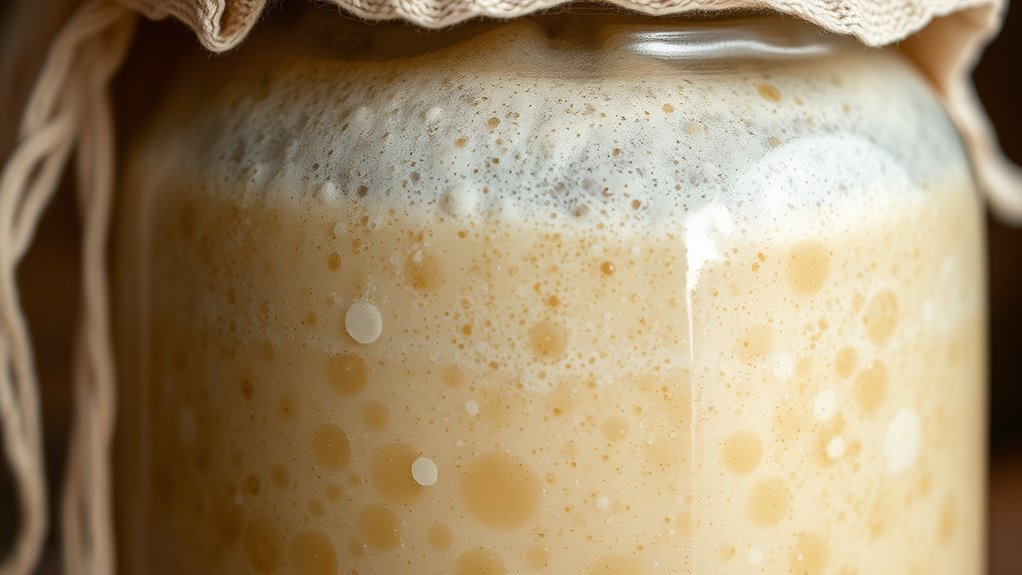
Yeast and bacteria in a sourdough starter follow distinct yet interconnected metabolic pathways that drive fermentation. Yeast primarily breaks down sugars through alcoholic fermentation, converting glucose into ethanol and carbon dioxide, which leavens the dough. They can’t ferment all flour sugars, so bacteria step in to utilize the remaining ones. Lactic acid bacteria (LAB) metabolize sugars anaerobically, producing lactic and other organic acids that give sourness and lower pH. Some LAB are homofermentative, mainly producing lactic acid, while heterofermentative species create additional compounds like acetic acid. Bacteria also break down gluten via proteolysis, influencing dough texture. Their acid production inhibits spoilage microbes, while yeast’s CO₂ causes leavening. This metabolic synergy sustains a balanced, efficient fermentation process essential for sourdough’s flavor and structure. Additionally, the presence of fiber in flour can influence bacterial growth and fermentation dynamics, contributing to the complexity of sourdough development. The metabolic pathways involved are highly adaptable, allowing for a diverse range of flavor profiles and textures in sourdough bread.
Impact of Environmental Conditions on Fermentation

Environmental conditions play a crucial role in shaping the fermentation process of a sourdough starter. Temperature is essential: 20-30°C (68-86°F) supports ideal microbial activity, while cooler temperatures below 15°C (59°F) slow down fermentation. Too much heat above 35°C (95°F) can inhibit or kill microbes, disrupting the microbial balance.
Consistent temperatures allow microbes to adapt, but fluctuations stress the community, favoring hardy strains. pH levels below 4.5 suppress pathogens and promote acid-tolerant LAB and yeast, stabilizing the starter’s acidity and flavor.
Hydration impacts microbial dominance: lower hydration favors yeast, while higher hydration boosts LAB activity and gas retention. Exposure to light, oxygen, and ambient microbes also influences vitality, with anaerobic conditions favoring LAB and open environments increasing contamination risks. Additionally, the presence of vetted microbial strains can significantly enhance fermentation reliability and flavor consistency.
Chemical Changes During Fermentation
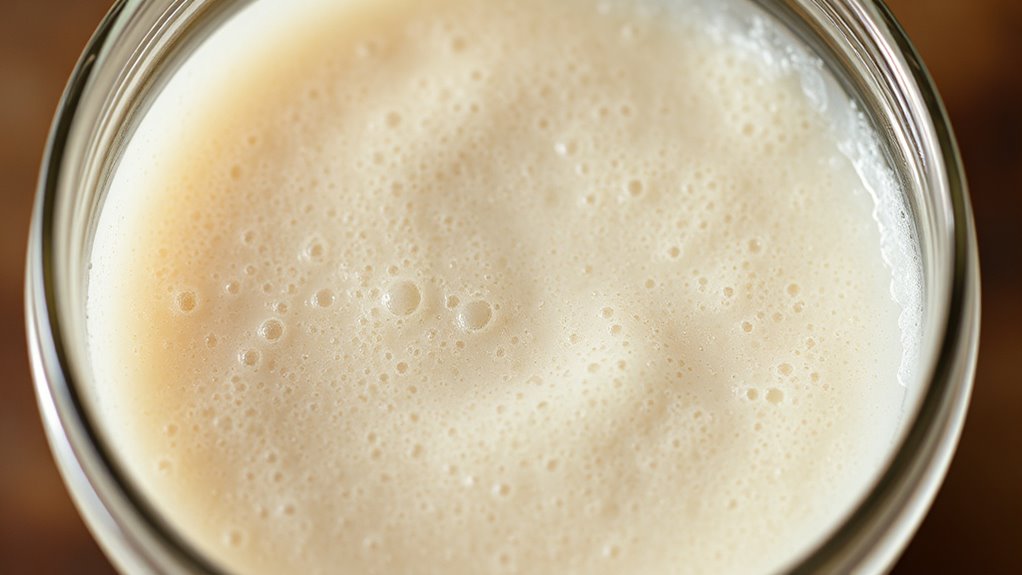
During fermentation, a series of chemical reactions transform the ingredients in your sourdough starter, creating the complex flavors and leavening effects you observe. Yeasts break down sugars through alcoholic fermentation, producing ethanol, carbon dioxide, and energy, which causes your dough to rise.
Meanwhile, bacteria generate organic acids like lactic and acetic acids, lowering the pH and giving sourdough its tangy flavor. These acids activate enzymes such as phytases and proteases, further breaking down starches and proteins.
The production of CO2 from both yeast and bacteria creates bubbles that leaven the dough. The acidic environment favors specific microorganisms, stabilizes the microbial community, and enhances flavor complexity.
Benefits of Sourdough Fermentation for Digestion and Nutrition
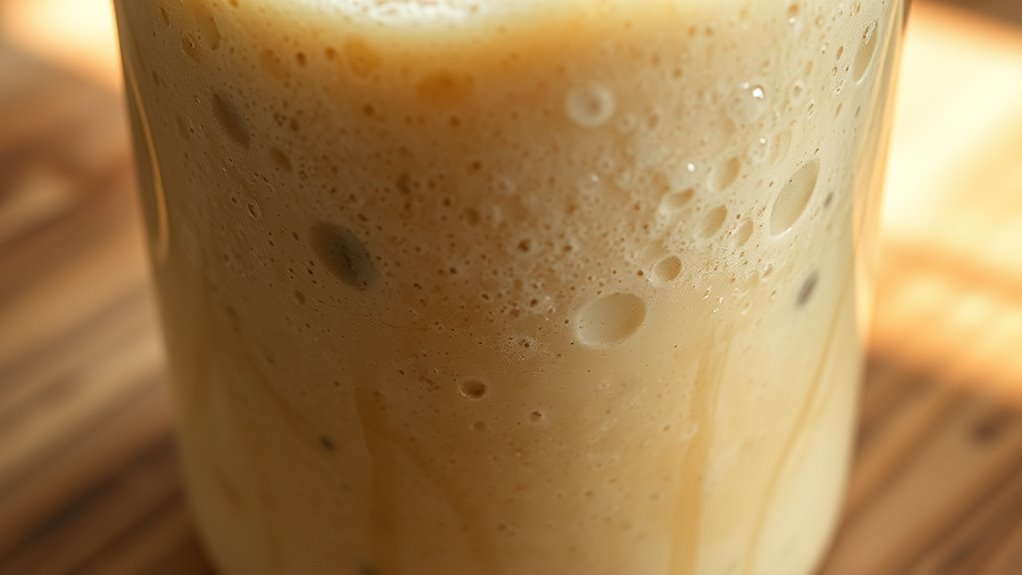
Sourdough fermentation offers significant health benefits by enhancing digestion and nutrient absorption. It reduces FODMAPs, making bread more tolerable for sensitive individuals and decreasing gas and bloating. The process breaks down phytic acid, freeing minerals like calcium and zinc for better absorption, while also releasing vitamins, amino acids, and antioxidants, boosting nutritional value.
Compared to standard yeast bread, sourdough is more digestible due to its lower pH and longer fermentation, which pre-digests complex carbohydrates and proteins. Additionally, beneficial bacteria like lactobacillus support gut health, potentially reducing irritation and promoting beneficial microbiota.
The acidity created during fermentation not only aids digestion but also helps the bread provide a quicker feeling of satiety, making sourdough a nourishing choice for overall digestive well-being.
Factors Influencing Sourdough Microbial Composition
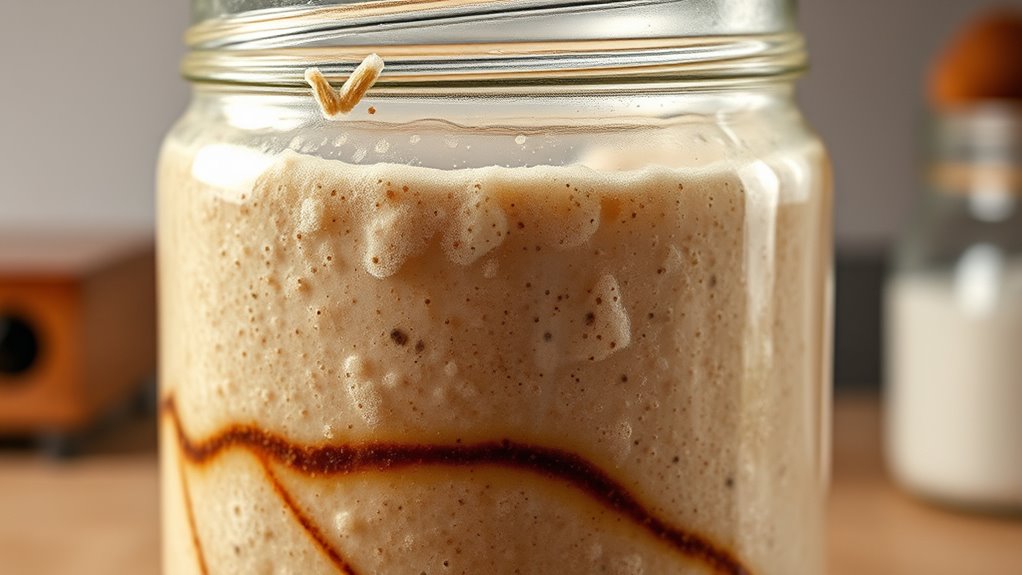
The microbial composition of your sourdough starter is shaped by a variety of factors, with geographic location playing a key role. Your home environment introduces microbes from the air, surfaces, and household flora, often more influence than the flour itself. Nearby soil, plants, and water sources also contribute microbes, creating a unique microbial fingerprint for each starter region.
The type and source of flour matter too—different cereals and batches carry distinct native microbes, affecting fermentation. Maintenance practices, like feeding frequency and hydration level, influence which microbes thrive. Regular feeding encourages beneficial bacteria like Lactobacillus and yeasts such as Saccharomyces, shaping the starter’s microbial balance.
Frequently Asked Questions
How Does the Microbial Balance in Sourdough Change Over Time?
You might wonder how the microbial balance in your sourdough changes over time. As fermentation progresses, certain bacteria and yeast species become dominant, shaping the starter’s characteristics.
Factors like feeding schedules, flour types, and environmental conditions can shift this balance. Over days or weeks, the microbial community stabilizes or fluctuates, influencing flavor, rise, and aroma.
Ultimately, these changes create a unique and developing sourdough profile.
Can Environmental Microbes Contaminate and Spoil a Sourdough Starter?
Yes, environmental microbes can contaminate and spoil your sourdough starter. They often enter through airborne spores, unclean utensils, or improper storage.
This is especially true if you neglect regular feeding or sanitation. These microbes, like molds or unwanted bacteria, can cause off-odors, discoloration, or visible mold growth.
To prevent this, keep your starter in clean containers, maintain a consistent feeding schedule, and avoid exposing it to dust and unsterilized surfaces.
What Specific Nutrients Do Yeast and Bacteria Need During Fermentation?
You might wonder what nutrients yeast and bacteria need during fermentation. They rely on simple sugars like glucose, maltose, and fructose for energy and growth.
Yeasts also need amino acids and proteins, which they break down into peptides.
Bacteria benefit from minerals like calcium, iron, zinc, and magnesium, especially when phytates are reduced.
Additionally, vitamins such as B2, B9, and D support microbial health and enhance the bread’s nutritional value.
How Do Different Flour Types Affect Microbial Community Development?
You wonder how different flour types affect microbial community development. When you choose whole wheat or rye, you provide more nutrients and enzymes, encouraging diverse and active microbes.
All-purpose flour offers a moderate environment, while gluten-free options may need adjustments for ideal growth.
Mixing flours helps tailor fermentation, balancing nutrient levels and microbial diversity, which impacts proofing times, flavor, and texture.
Your choice of flour directly influences the microbial ecosystem in your sourdough starter.
Is It Possible to Revive a Dormant or Neglected Sourdough Starter?
Yes, you can revive a dormant or neglected sourdough starter. You discard most of the old, dark liquid, keep a small amount, and feed it with fresh flour and water.
Keep it at room temperature, stir regularly, and monitor for bubbles and volume doubling. With patience and consistent feeding, your starter will wake up, bubble, and be ready to bake again.
Stay attentive, and your starter will come back to life.
Conclusion
Understanding sourdough fermentation reveals a delicate dance of microbes working in harmony, subtly shaping flavor and health benefits. As you nurture your starter, you’re inviting a symphony of tiny players that enrich your bread and your well-being. With patience and care, you foster a process that whispers centuries of tradition into every crumb. Embrace this gentle art, and you’ll discover that the true magic lies in the quiet transformations happening within each loaf.
